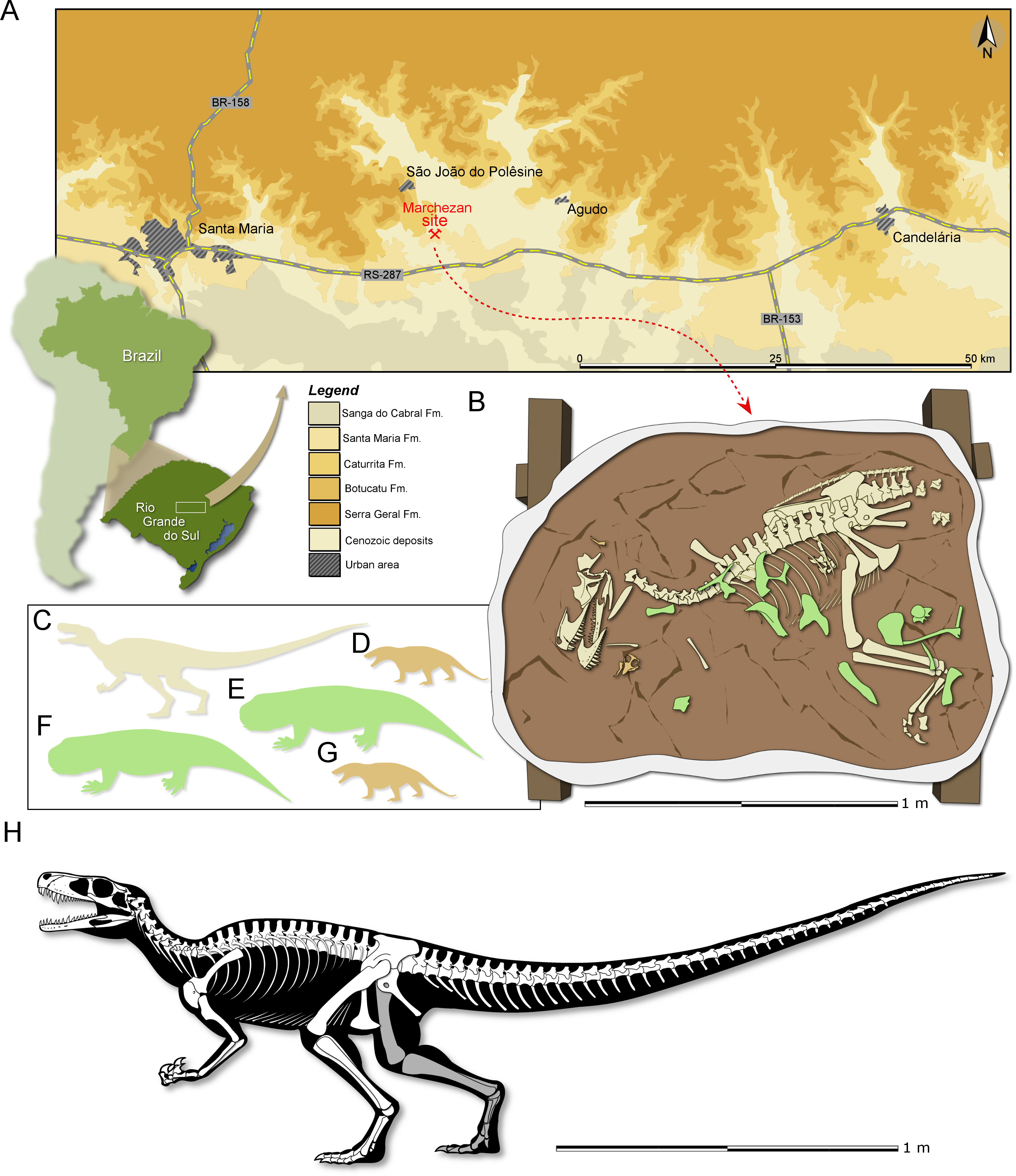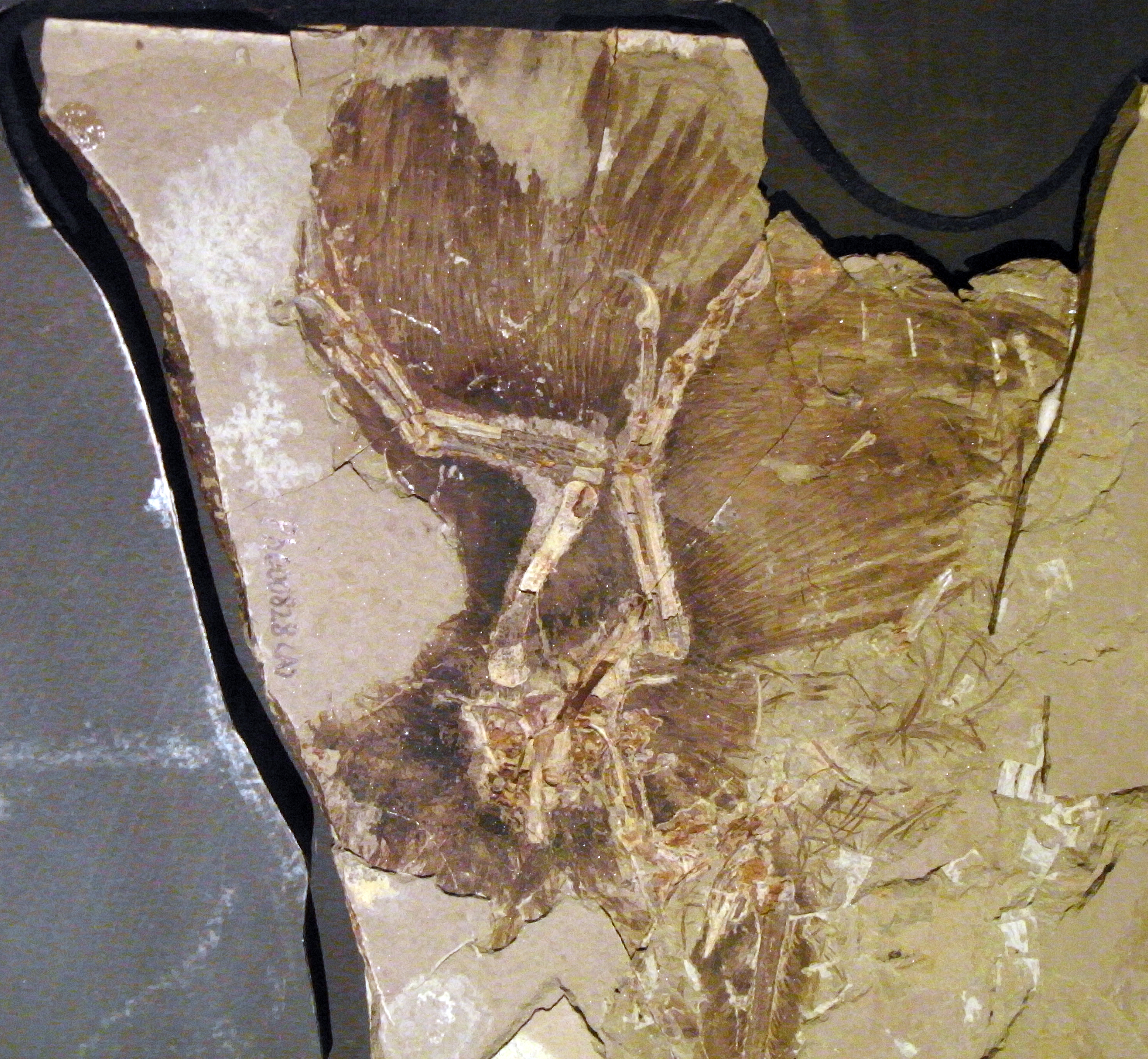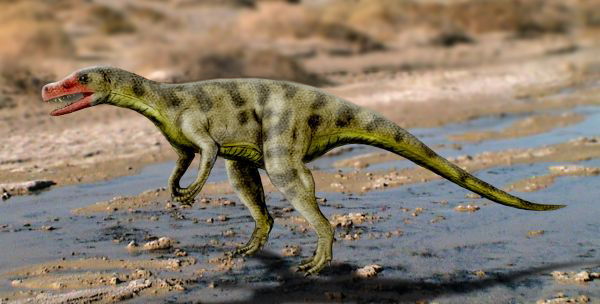|
Herrerasaur
Herrerasauridae is a family of carnivorous dinosaurs, possibly basal to either theropods or even all of saurischians, or even their own branching from dracohors, separate from dinosauria altogether. They are among the oldest known dinosaurs, first appearing in the fossil record around 233.23 million years ago (the Carnian stage of the Late Triassic), before becoming extinct by the end of the Carnian stage. Herrerasaurids were relatively small-sized dinosaurs, normally no more than long, although the holotype specimen of "''Frenguellisaurus ischigualastensis"'' (nowadays considered a synonym of ''Herrerasaurus'' ''ischigualastensis'') is thought to have reached around 6 meters (20 ft) long. The best known representatives of this group are from South America (Brazil, Argentina), where they were first discovered in the 1930s in relation to ''Staurikosaurus'' and 1960s in relation to ''Herrerasaurus''. A nearly complete skeleton of ''Herrerasaurus ischigualastensis'' was discovered ... [...More Info...] [...Related Items...] OR: [Wikipedia] [Google] [Baidu] |
Herrerasaurus
''Herrerasaurus'' is a genus of saurischian dinosaur from the Late Triassic period. This genus was one of the earliest dinosaurs from the fossil record. Its name means "Herrera's lizard", after the rancher who discovered the first specimen in 1958 in South America. All known fossils of this carnivore have been discovered in the Ischigualasto Formation of Carnian age (late Triassic according to the ICS, dated to 231.4 million years ago) in northwestern Argentina. The type species, ''Herrerasaurus ischigualastensis'', was described by Osvaldo Reig in 1963 and is the only species assigned to the genus. ''Ischisaurus'' and ''Frenguellisaurus'' are synonyms. For many years, the classification of ''Herrerasaurus'' was unclear because it was known from very fragmentary remains. It was hypothesized to be a basal theropod, a basal sauropodomorph, a basal saurischian, or not a dinosaur at all but another type of archosaur. However, with the discovery of an almost complete skeleton ... [...More Info...] [...Related Items...] OR: [Wikipedia] [Google] [Baidu] |
Staurikosaurus
''Staurikosaurus'' (Pronounced "STORE-ee-koh-SAWR-us", "Southern Cross lizard") is a genus of herrerasaurid dinosaur from the Late Triassic of Brazil, found in the Santa Maria Formation. Description Colbert (1970) described ''Staurikosaurus'' as a small and agile, bipedal predator.Colbert, E. H. (1970). A Saurischian dinosaur from the Triassic of Brazil. AM. MUS. NOVITATES 2405; 1-39 ''Staurikosaurus'' lived during the late-Carnian and early-Norian stage, of the Late Triassic, approximately 225 million years ago—which makes it one of the earliest dinosaurs known. Its length is measured at long,Grillo, O.N. and Azevedo, S.A.K. (2011). "Recovering missing data: estimating position and size of caudal vertebrae in ''Staurikosaurus pricei'' Colbert, 1970." ''Annals of the Brazilian Academy of Sciences'', but Gregory S. Paul presented a lower length estimate of and a body mass estimate of . ''Staurikosaurus'' was small in comparison to later theropods like ''Megalosaurus''. The ... [...More Info...] [...Related Items...] OR: [Wikipedia] [Google] [Baidu] |
Saurischia
Saurischia ( , meaning "reptile-hipped" from the Greek ' () meaning 'lizard' and ' () meaning 'hip joint') is one of the two basic divisions of dinosaurs (the other being Ornithischia), classified by their hip structure. Saurischia and Ornithischia were originally called orders by Harry Seeley in 1888 though today most paleontologists classify Saurischia as an unranked clade rather than an order.Weishampel, D.B., Dodson, P., and Osmólska, H. (eds.). (2004). ''The Dinosauria. 2nd edition''. University of California Press, Berkeley. 833 pp. Description All carnivorous dinosaurs (certain types of theropods) are traditionally classified as saurischians, as are all of the birds and one of the two primary lineages of herbivorous dinosaurs, the sauropodomorphs. At the end of the Cretaceous Period, all saurischians except the birds became extinct in the course of the Cretaceous–Paleogene extinction event. Birds, as direct descendants of one group of theropod dinosaurs, are a sub-clad ... [...More Info...] [...Related Items...] OR: [Wikipedia] [Google] [Baidu] |
Gnathovorax
''Gnathovorax'' is a genus of herrerasaurid saurischian dinosaur from the Santa Maria Formation in Rio Grande do Sul, Brazil. The type and only species is ''Gnathovorax cabreirai'', described by Pacheco ''et al.'' in 2019. The type specimen comprises a mostly complete and well-preserved articulated skeleton (considered one of the best herrerasaurid skeletons ever discovered), which fossilized in close association with rhynchosaur and cynodont remains. The discovery of this superb specimen has shed light onto poorly understood aspects of herrerasaurid anatomy such as endocranial soft tissues. Discovery The holotype specimen, CAPPA/UFSM 0009, is an almost complete and partially articulated skeleton, lacking only portions of the left shoulder girdle and left forelimb. It was found in 2014 at the Marchezan site, in the municipality of São João do Polêsine, Rio Grande do Sul, Brazil. This locality preserved rocks from Santa Maria Formation in the Candelária Sequence of th ... [...More Info...] [...Related Items...] OR: [Wikipedia] [Google] [Baidu] |
Chindesaurus
''Chindesaurus'' ( ) is an extinct genus of basal saurischian dinosaur from the Late Triassic (213-210 million years ago) of the southwestern United States. It is known from a single species, ''C. bryansmalli'', based on a partial skeleton recovered from Petrified Forest National Park in Arizona. The original specimen was nicknamed "Gertie", and generated much publicity for the park upon its discovery in 1984 and airlift out of the park in 1985. Other fragmentary referred specimens have been found in Late Triassic sediments throughout Arizona, New Mexico, and Texas, but these may not belong to the genus. ''Chindesaurus'' was a bipedal carnivore, approximately as large as a wolf.Holtz, Thomas R. Jr. (2012) ''Dinosaurs: The Most Complete, Up-to-Date Encyclopedia for Dinosaur Lovers of All Ages,'Winter 2011 Appendix./ref> ''Chindesaurus'''s classification is debated, and various papers have had different conclusions on its affinities. Its fossils were originally believed to belong to " ... [...More Info...] [...Related Items...] OR: [Wikipedia] [Google] [Baidu] |
Dracohors
Dinosauromorpha is a clade of avemetatarsalian archosaurs (reptiles closer to birds than to crocodilians) that includes the Dinosauria (dinosaurs) and some of their close relatives. It was originally defined to include dinosauriforms and lagerpetids, with later formulations specifically excluding pterosaurs from the group. Birds are the only dinosauromorphs which survive to the present day. Classification The name "Dinosauromorpha" was briefly coined by Michael J. Benton in 1985. It was considered an alternative name for the group "Ornithosuchia", which was named by Jacques Gauthier to correspond to archosaurs closer to dinosaurs than to crocodilians. Although "Ornithosuchia" was later recognized as a misnomer (since ornithosuchids are now considered closer to crocodilians than to dinosaurs), it was still a more popular term than Dinosauromorpha in the 1980s. The group encompassed by Gauthier's "Ornithosuchia" and Benton's "Dinosauromorpha" is now given the name Avemet ... [...More Info...] [...Related Items...] OR: [Wikipedia] [Google] [Baidu] |
Dinosaur
Dinosaurs are a diverse group of reptiles of the clade Dinosauria. They first appeared during the Triassic period, between 243 and 233.23 million years ago (mya), although the exact origin and timing of the evolution of dinosaurs is the subject of active research. They became the dominant terrestrial vertebrates after the Triassic–Jurassic extinction event 201.3 mya; their dominance continued throughout the Jurassic and Cretaceous periods. The fossil record shows that birds are feathered dinosaurs, having evolved from earlier theropods during the Late Jurassic epoch, and are the only dinosaur lineage known to have survived the Cretaceous–Paleogene extinction event approximately 66 mya. Dinosaurs can therefore be divided into avian dinosaurs—birds—and the extinct non-avian dinosaurs, which are all dinosaurs other than birds. Dinosaurs are varied from taxonomic, morphological and ecological standpoints. Birds, at over 10,700 living species, are among ... [...More Info...] [...Related Items...] OR: [Wikipedia] [Google] [Baidu] |
Theropoda
Theropoda (; ), whose members are known as theropods, is a dinosaur clade that is characterized by hollow bones and three toes and claws on each limb. Theropods are generally classed as a group of saurischian dinosaurs. They were ancestrally carnivorous, although a number of theropod groups evolved to become herbivores and omnivores. Theropods first appeared during the Carnian age of the late Triassic Period (geology), period 231.4 million years ago (Year#SI prefix multipliers, Ma) and included all the large terrestrial carnivores from the Early Jurassic until at least the close of the Cretaceous, about 66 Ma. In the Jurassic, birds evolved from small specialized coelurosaurian theropods, and are today represented by about 10,500 living species. Biology Diet and teeth Theropods exhibit a wide range of diets, from insectivores to herbivores and carnivores. Strict carnivory has always been considered the ancestral diet for theropods as a group, and a wider variety of di ... [...More Info...] [...Related Items...] OR: [Wikipedia] [Google] [Baidu] |
Theropods
Theropoda (; ), whose members are known as theropods, is a dinosaur clade that is characterized by hollow bones and three toes and claws on each limb. Theropods are generally classed as a group of saurischian dinosaurs. They were ancestrally carnivorous, although a number of theropod groups evolved to become herbivores and omnivores. Theropods first appeared during the Carnian age of the late Triassic period 231.4 million years ago ( Ma) and included all the large terrestrial carnivores from the Early Jurassic until at least the close of the Cretaceous, about 66 Ma. In the Jurassic, birds evolved from small specialized coelurosaurian theropods, and are today represented by about 10,500 living species. Biology Diet and teeth Theropods exhibit a wide range of diets, from insectivores to herbivores and carnivores. Strict carnivory has always been considered the ancestral diet for theropods as a group, and a wider variety of diets was historically considered a characteri ... [...More Info...] [...Related Items...] OR: [Wikipedia] [Google] [Baidu] |
Sanjuansaurus
''Sanjuansaurus'' (" San Juan Province lizard") is a genus of herrerasaurid dinosaur from the Late Triassic (Carnian) Cancha de Bochas and La Peña Members of the Ischigualasto Formation of the Ischigualasto-Villa Unión Basin in northwestern Argentina. Description and classification ''Sanjuansaurus'' was comparable in size to a medium-sized ''Herrerasaurus'', with a thigh bone that was long and a tibia that is in length (in the description paper the tibia is listed with 260 mm in length due to a typo). Alcober and Martinez performed a phylogenetic analysis and found ''Sanjuansaurus'' to be a herrerasaurid. It was determined that ''Sanjuansaurus'' and'' Herrerasaurus'' share many similarities in the morphology of the skull, neck vertebrae, back vertebrae, hip vertebrae, scapula, and the hip bones. Alcober and Martinez observed that ''Sanjuansaurus'' and'' Staurikosaurus ''share many similarities in the morphology of the hip bones, and the tibia. The pubis of ''Sanjuansauru ... [...More Info...] [...Related Items...] OR: [Wikipedia] [Google] [Baidu] |
Ischigualasto Provincial Park
Ischigualasto Provincial Park ( es, Parque Provincial Ischigualasto), also called ''Valle de la Luna'' ("Valley of the Moon" or "Moon Valley"), due to its moon like appearance, is a provincial protected area in the north-east of San Juan Province, north-western Argentina, limiting to the north with the Talampaya National Park, in La Rioja Province. Both areas belong to the same geological formation, the Ischigualasto Formation (sometimes called the Ischigualasto-Talampaya Formation). Established on 3 November 1971, the park has an area of . In 2000, UNESCO included Ischigualasto and Talampaya National Park among its World Heritage Sites. History The name Ischigualasto is derived from the extinct Cacán language, spoken by an indigenous group referred to as the Diaguita by the Spanish conquistadors and means "place where the moon alights". Another hypothesis gives the name "Ischigualasto" a Quechua origin, meaning "dead land", although some scholars have proposed Huarpe root ... [...More Info...] [...Related Items...] OR: [Wikipedia] [Google] [Baidu] |
Carnian
The Carnian (less commonly, Karnian) is the lowermost stage of the Upper Triassic Series (or earliest age of the Late Triassic Epoch). It lasted from 237 to 227 million years ago (Ma). The Carnian is preceded by the Ladinian and is followed by the Norian. Its boundaries are not characterized by major extinctions or biotic turnovers, but a climatic event (known as the Carnian pluvial episode characterized by substantial rainfall) occurred during the Carnian and seems to be associated with important extinctions or biotic radiations. Stratigraphic definitions The Carnian was named in 1869 by Mojsisovics. It is unclear if it was named after the Carnic Alps or after the Austrian region of Carinthia (''Kärnten'' in German) or after the Carnia historical region in northwestern Italy. The name, however, was first used referring to a part of the Hallstatt Limestone cropping out in Austria. The base of the Carnian Stage is defined as the place in the stratigraphic record where t ... [...More Info...] [...Related Items...] OR: [Wikipedia] [Google] [Baidu] |











